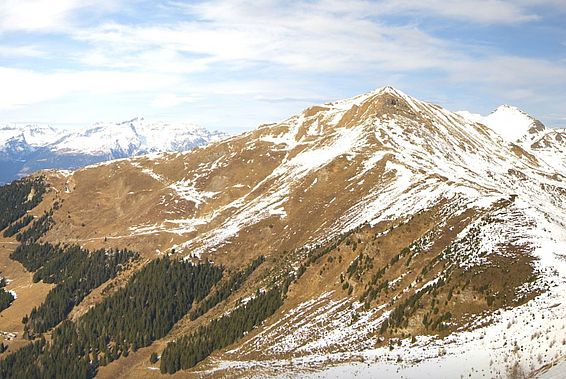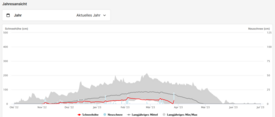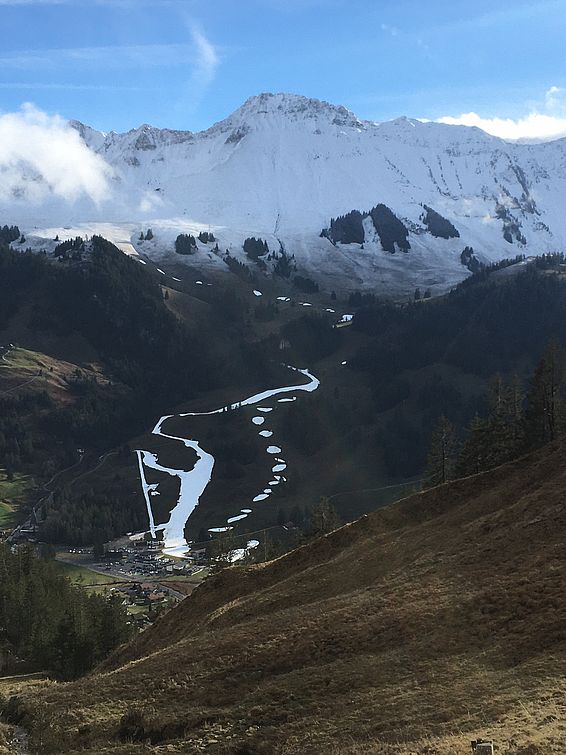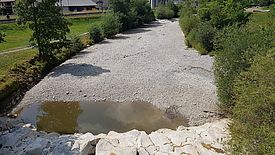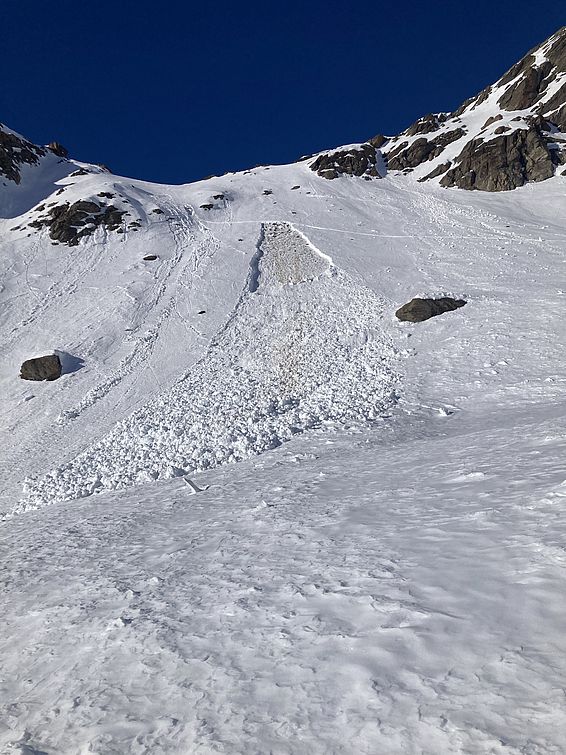For weeks, the WSL Institute for Snow and Avalanche Research (SLF) has been receiving a lot of enquiries about the current lack of snow, its impacts this summer and the long-term prospects for the decades ahead. In this FAQ, you can find our experts' answers to the 11 most frequently asked questions.
The FAQ reflects the situation in mid-March 2023. You can read about the winter as a whole in the Winter Report 2022/23. (German / French)
Has there been an unusual lack of snow over the winter as a whole?
The snowfall is well below average at many of the 80 measuring stations in the Alps, and that has been the case throughout the winter. Indeed, in late February, snow depths hit record lows in many places. Above 1,000 metres, 40% of the stations had less snow than the average for the past 70 years.
Is the current situation comparable to other periods in the past?
It is true that there have been winters with a similar lack of snow in the past. However, as a rule, extensive snowfall subsequently compensated for the deficit. In this period of climate change with its warmer temperatures, it is possible that extensive snowfall will only be encountered at high altitudes, but this will not be of much use, given the relatively small area where such altitudes occur.
Does the lack of snow differ between altitudes or regions?
In general, every winter there is more snow at high altitudes and on northern slopes than on the plains and on southern slopes. However, this is more noticeable in winters with little snow, like this one, as southern locations are often green because they have no snow at all. However, there can be substantial regional differences. This winter, there was more snow in south-western Switzerland, especially the higher elevations of western Valais, than the rest of Switzerland. A long-term comparison, though, reveals that even in that region there was relatively little snow. Anyone looking for a precise, interactive comparison for specific locations with long-term minima, maxima and averages will find what they are looking for here.
What are the reasons for the lack of snow this winter?
High-pressure areas over Western Europe blocked precipitation fronts, resulting in a lack of substantial snowfall events. Since November, there has rarely been more than ten centimetres of snowfall at a time (if any), except in south-western Switzerland, especially Valais. On top of this, for long periods temperatures were too high for snow. This combination of warmth and drought significantly reduced snow cover. Now, even at higher altitudes, we are seeing some initial spots where the ground is visible. From these the snowmelt can expand rapidly, because the earth is already warming up in these places. In this case even fresh snow hardly helps because if it falls where there is no snow cover, it often does not stay for long.
The image taken by the infrared camera shows how warm air is moved by wind from above the free ground on the left to the area above the snow cover. SLF scientist Michael Haugeneder explains how the measurement works in the video here. (Video: Michael Haugeneder / SLF)
How long would it have to snow to make up for the deficit?
There have been winters with a lack of snow in the past when sudden, heavy precipitation compensated for the deficit. However, to turn this particular low into an average year, we would need a lot of snow within a short period. There would have to be 100 millimetres of precipitation across Switzerland, and as much as 200 millimetres in mountainous regions. The chances of this happening, though, are slim. To make matters worse, the temperatures are already spring-like, causing snow to melt faster. If the precipitation was only in the form of rain, a month of continuous rainfall would make up for the deficit. However, unlike snow, rainwater is not temporarily immobilised, so a large part goes straight into rivers and lakes. As a result, it does not have the regulating effect of snowmelt on the water balance.
What role is climate change playing?
The current lack of snow is mainly due to the low levels of precipitation. However, the warmer temperatures caused by climate change are further exacerbating the situation. In the long term, we can see that, depending on location and elevation, there have been up to 60% fewer days of snow in the past 30 years than in the period from 1963 to 1992. Historical records also show that in the past 500 years there has never been so little snow on the Swiss Plateau as in the last few decades. If the earth's temperatures continues to rise at the current rate, Zurich will see more than a week of snow only once every 15 years from 2050. Between 1963 and 1992, the average was as much as 34 days.
Will winters like this one be the norm in the future?
The long-term trend is clear from a range of studies. In the last few decades, the average value has substantially decreased, for example by almost 30% from 51 to 36 centimetres in Sedrun in the past 30 years alone, and by around 43% from 78 to 44 centimetres in Klosters. The number of periods with wet snow is already increasing. By the middle of the 21st century, snow at low altitudes – if there is any at all – is likely to melt immediately. On average, in the next 30 years in the Jura, for example, there will no longer be 50 days of fresh snow per season, whereas that was the absolute minimum between 1981 and 2010. However, a lot also depends on future weather conditions. North-westerly flows bring cold polar air and snow, and south-westerly ones warm air. Although the east wind is cold, it hardly brings any precipitation.
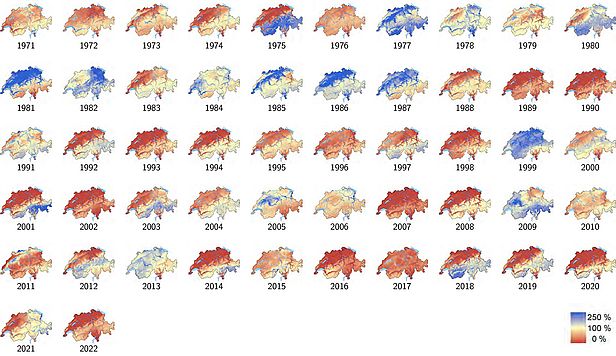
What does the lack of snow mean for winter sports resorts?
Given the comparatively high temperatures at the turn of the year, it was not possible for many winter sports resorts to produce machine-made snow – often called 'artificial snow' – to compensate for the shortage they were facing. Climate scenarios show that the zero-degree level will rise to an altitude range between 1,300 and 1,800 metres by 2050. Even there, winter sports will no longer be possible with natural snow alone. Lower-lying destinations would be well advised to have a rethink and start developing ideas now about what reasons and activities they can use to attract visitors if there is no snow.
What can we expect this summer if it is so dry now?
The current lack of snow potentially means drought this summer. With snow levels this winter falling well short of long-term averages, drought is likely to be a problem again this summer if there is a continuing lack of precipitation. This would be the second summer of drought in a row, with last summer following another winter (2021/22) with a lack of snow. Even if it does rain, this is unlikely to compensate for the shortage. That would require above-average rainfall and snowfall in the weeks ahead.
According to a recent SLF study, the duration of drought periods has decreased in recent decades, but their intensity has increased – and throughout the Alpine region. A long-term comparison also shows that between 1994 and 2017, a lack of snow was responsible for low water levels in Swiss watercourses around 15% more often than between 1970 and 1993.
What are the effects of drought on water supply, vegetation, agriculture and hydroelectric power generation?
They are obvious in agriculture and forestry, because dry conditions in summer and autumn cause problems for a range of plants, from grasses and shrubs through to trees. Among other things, winegrowers are likely to see poor yields in 2023, as they did in 2022.
On top of this, cantons can impose bans on water extraction when water levels are low. Farms would then not be allowed to use water for irrigation purposes, and the same would apply to households with a garden.
Researchers from the SLF and the Swiss Federal Institute for Forest, Snow and Landscape Research (WSL) are also anticipating problems at high altitudes. Alpine farming is only viable if there is enough fresh water – and that is likely to be scarce in 2023, as in 2022, when the season ended earlier due to the drought. During the 2018 drought, some farmers even had to slaughter their cattle.
Drought would also cause power shortages, because a lack of precipitation reduces the amount of electricity that hydroelectric power plants can generate, due to falling reservoir levels.
The waterways, especially the Rhine, are also vital for Switzerland, as they bring in a lot of the country's imported goods. Low water levels force ships to travel more slowly and transport smaller volumes, as happened in summer 2022.
Does the unusual snowfall situation also create special conditions and hazards in terms of avalanches?
To some extent. If it rains more frequently at high altitudes in winter, wet snow avalanches could even happen at an altitude of 2,500 metres, and much earlier than usual. In the last 20 years, the period in which wet snow avalanches are a hazard has moved forward by an average of three weeks. This trend will continue, meaning that in the future, wet snow avalanches will peak in March and no longer in May, as has been the case up to now. However, the SLF does not expect the general avalanche hazard to decrease in the years ahead. It could even increase, especially at high altitudes. However, there is a great deal of uncertainty involved in such forecasts. Avalanches will probably not encroach as far into valleys as they have in the past though, as they will encounter wet snow beforehand, slowing them down. Another risk is from drought: if this leads to fires or pest infestation in protection forests, causing these to collapse, this could locally increase the hazard level.
Copyright ¶
WSL and SLF provide the artwork for imaging of press articles relating to this media release for free. Transferring and saving the images in image databases and saving of images by third parties is not allowed.
